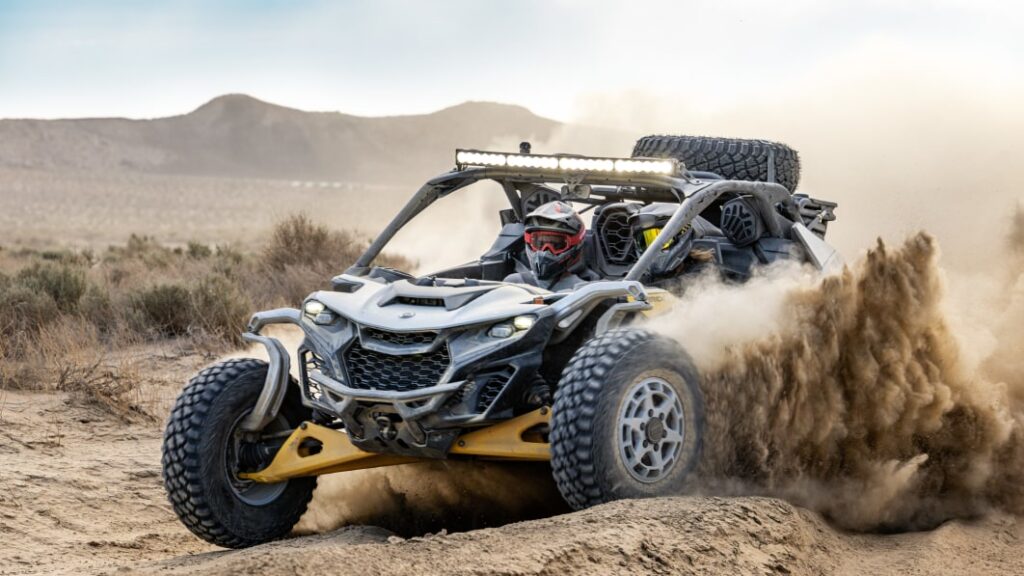2024 Can-Am Maverick R brings big power, new tech, and a wild suspension

It’s been a big summer for Polaris, the brand working to expand how outdoor types perceive UTVs with the launches of the Xpedition overland rig and the 1500 heavy-duty side-by-side. Before that, the Minnesota company declared its loftier racing intentions by launching its first dedicated racing UTV, the RZR Pro R Factory. The folks in Quebec at Can-Am have been watching, the arrival of the all-new Maverick R lineup perhaps the first salvo declaring Can-Am plans to claim the autumn. This perceptions this one wants to expand are those of power, speed, suspension travel, and what an UTV suspension is meant to look like.
The three-strong lineup consists up the Maverick R, the R X, and R X RS. The R X RS can be had with Fox Podium shocks or Fox’s electronically adaptive Smart Shox units. The UTVs are 77 inches wide on a 108-inch wheelbase.
Bombardier Recreational Products, the parent company of Can-Am, also owns Austrian engine maker Rotax. The heart of the Maverick R is cradled in a tubular steel cage and comes from the Alps, a turbocharged 999-cc three-cylinder Rotax. The closed deck, aluminum block triple with a dry sump oil system makes 240 horsepower, 15 horses more than the Polaris RZR Pro R and setting a new bar for stock output. Tech bits includ dual injectors for each cylinder and an electronically controlled wastegate. With the help of that wastegate, engineers developed a boost pre-load system that acts like launch control by shutting down the middle cylinder. It can be activated in Sport+ driving mode, the most aggressive after Normal and Sport.
The Rotax engine is bolted to Rotax’s first-ever dual-clutch transmission, a seven-speed ‘box with high and low ranges that can be shifted on the fly. In one Maverick trim, it can be worked with paddle shifters. This is the second dual-clutch gearbox on the market following Honda breaking the DCT seal with its Talon and Pioneer UTVs. This is a welcome step. The powersports segment has used CVTs for years, and they’re plenty of fun; yet, now that more UTVs are priced like nice cars, it’s time to step up.
The design that’s going to get a lot of eyeballs and ink is the tall-knuckle suspension. Stamped steel upper and lower control arms hold a forged aluminum knuckle with its upper ball joint above the front tire. The simple benefits are 25 inches of travel in front, 26 inches in back in a trailing arm setup. These are high-dollar race rig numbers from what’s claimed to be the longest Fox shocks on a factory UTV. According to Can-Am, the more complex benefits are better stability, higher torsional rigidity, reduced stress on components, and great for a side-by-side, a repositioned roll center that helps make the rig less inclined to roll over. The company also says the aluminum arms are plenty strong.
The coilovers suspend 15 or 16-inch aluminum wheels depending on trim. The 16-inch wheels get a six-lug pattern common to pickups, vastly expanding an owner’s wheel options. Stock tires are either 30-inch or 32-inch ITP Tenacity XNRs, the factory setup can accept tires up to 35 inches. Behind the wheels, a three-piston brake caliper clamps a 10.4-inch front disc, and a two-piston caliper in back grips a 10-inch disc.
Carlike features dot the interior, like the 10.25-inch infotainment screen on equipped models, the buttons on the steering wheel, the telescoping steering column, paddle shifters,
The Maverick R starts at $35,499 before destination and the varying commodity fees Polaris and Can-Am charge. The Maverick R X starts at $38,399, the R X RS at $42,599 with mechanical Live Valve shocks, or $44,299 with the electronic Smart Shox. As others have already found, you can option that flagship RX RS beyond $70,000 on the Can-Am configurator.


